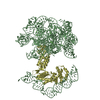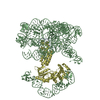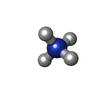[English] 日本語
 Yorodumi
Yorodumi- PDB-8t2r: Structure of a group II intron ribonucleoprotein in the pre-ligat... -
+ Open data
Open data
- Basic information
Basic information
| Entry | Database: PDB / ID: 8t2r | ||||||
|---|---|---|---|---|---|---|---|
| Title | Structure of a group II intron ribonucleoprotein in the pre-ligation (pre-2F) state | ||||||
 Components Components |
| ||||||
 Keywords Keywords | Transferase/RNA / RNP / RNA / Transferase-RNA complex | ||||||
| Function / homology |  Function and homology information Function and homology information | ||||||
| Biological species |  [Eubacterium] rectale (bacteria) [Eubacterium] rectale (bacteria) | ||||||
| Method | ELECTRON MICROSCOPY / single particle reconstruction / cryo EM / Resolution: 3.1 Å | ||||||
 Authors Authors | Xu, L. / Liu, T. / Chung, K. / Pyle, A.M. | ||||||
| Funding support |  United States, 1items United States, 1items
| ||||||
 Citation Citation |  Journal: Nature / Year: 2023 Journal: Nature / Year: 2023Title: Structural insights into intron catalysis and dynamics during splicing. Authors: Ling Xu / Tianshuo Liu / Kevin Chung / Anna Marie Pyle /  Abstract: The group II intron ribonucleoprotein is an archetypal splicing system with numerous mechanistic parallels to the spliceosome, including excision of lariat introns. Despite the importance of ...The group II intron ribonucleoprotein is an archetypal splicing system with numerous mechanistic parallels to the spliceosome, including excision of lariat introns. Despite the importance of branching in RNA metabolism, structural understanding of this process has remained elusive. Here we present a comprehensive analysis of three single-particle cryogenic electron microscopy structures captured along the splicing pathway. They reveal the network of molecular interactions that specifies the branchpoint adenosine and positions key functional groups to catalyse lariat formation and coordinate exon ligation. The structures also reveal conformational rearrangements of the branch helix and the mechanism of splice site exchange that facilitate the transition from branching to ligation. These findings shed light on the evolution of splicing and highlight the conservation of structural components, catalytic mechanism and dynamical strategies retained through time in premessenger RNA splicing machines. | ||||||
| History |
|
- Structure visualization
Structure visualization
| Structure viewer | Molecule:  Molmil Molmil Jmol/JSmol Jmol/JSmol |
|---|
- Downloads & links
Downloads & links
- Download
Download
| PDBx/mmCIF format |  8t2r.cif.gz 8t2r.cif.gz | 394.9 KB | Display |  PDBx/mmCIF format PDBx/mmCIF format |
|---|---|---|---|---|
| PDB format |  pdb8t2r.ent.gz pdb8t2r.ent.gz | 299.2 KB | Display |  PDB format PDB format |
| PDBx/mmJSON format |  8t2r.json.gz 8t2r.json.gz | Tree view |  PDBx/mmJSON format PDBx/mmJSON format | |
| Others |  Other downloads Other downloads |
-Validation report
| Summary document |  8t2r_validation.pdf.gz 8t2r_validation.pdf.gz | 1.4 MB | Display |  wwPDB validaton report wwPDB validaton report |
|---|---|---|---|---|
| Full document |  8t2r_full_validation.pdf.gz 8t2r_full_validation.pdf.gz | 1.4 MB | Display | |
| Data in XML |  8t2r_validation.xml.gz 8t2r_validation.xml.gz | 43.3 KB | Display | |
| Data in CIF |  8t2r_validation.cif.gz 8t2r_validation.cif.gz | 66.5 KB | Display | |
| Arichive directory |  https://data.pdbj.org/pub/pdb/validation_reports/t2/8t2r https://data.pdbj.org/pub/pdb/validation_reports/t2/8t2r ftp://data.pdbj.org/pub/pdb/validation_reports/t2/8t2r ftp://data.pdbj.org/pub/pdb/validation_reports/t2/8t2r | HTTPS FTP |
-Related structure data
| Related structure data |  40985MC  8t2sC  8t2tC M: map data used to model this data C: citing same article ( |
|---|---|
| Similar structure data | Similarity search - Function & homology  F&H Search F&H Search |
- Links
Links
- Assembly
Assembly
| Deposited unit | 
|
|---|---|
| 1 |
|
- Components
Components
| #1: Protein | Mass: 49083.914 Da / Num. of mol.: 1 Source method: isolated from a genetically manipulated source Source: (gene. exp.)  [Eubacterium] rectale (bacteria) / Gene: ltrA_2, ltrA, ERS852417_00966, FYL37_05080 / Production host: [Eubacterium] rectale (bacteria) / Gene: ltrA_2, ltrA, ERS852417_00966, FYL37_05080 / Production host:  References: UniProt: A0A173ZME3, RNA-directed DNA polymerase | ||||
|---|---|---|---|---|---|
| #2: RNA chain | Mass: 2097.219 Da / Num. of mol.: 1 Source method: isolated from a genetically manipulated source Source: (gene. exp.)  [Eubacterium] rectale (bacteria) / Production host: [Eubacterium] rectale (bacteria) / Production host:  | ||||
| #3: RNA chain | Mass: 208395.812 Da / Num. of mol.: 1 Source method: isolated from a genetically manipulated source Source: (gene. exp.)  [Eubacterium] rectale (bacteria) / Production host: [Eubacterium] rectale (bacteria) / Production host:  | ||||
| #4: Chemical | ChemComp-CA / #5: Chemical | Has ligand of interest | Y | |
-Experimental details
-Experiment
| Experiment | Method: ELECTRON MICROSCOPY |
|---|---|
| EM experiment | Aggregation state: PARTICLE / 3D reconstruction method: single particle reconstruction |
- Sample preparation
Sample preparation
| Component | Name: Intron RNP complex in pre-2f / Type: COMPLEX / Entity ID: #1-#3 / Source: RECOMBINANT |
|---|---|
| Molecular weight | Value: 0.3 MDa / Experimental value: NO |
| Source (natural) | Organism:  [Eubacterium] rectale (bacteria) [Eubacterium] rectale (bacteria) |
| Source (recombinant) | Organism:  |
| Buffer solution | pH: 7.5 |
| Specimen | Embedding applied: NO / Shadowing applied: NO / Staining applied: NO / Vitrification applied: YES |
| Vitrification | Cryogen name: ETHANE |
- Electron microscopy imaging
Electron microscopy imaging
| Experimental equipment |  Model: Titan Krios / Image courtesy: FEI Company |
|---|---|
| Microscopy | Model: FEI TITAN KRIOS |
| Electron gun | Electron source:  FIELD EMISSION GUN / Accelerating voltage: 300 kV / Illumination mode: FLOOD BEAM FIELD EMISSION GUN / Accelerating voltage: 300 kV / Illumination mode: FLOOD BEAM |
| Electron lens | Mode: DARK FIELD / Nominal defocus max: 2500 nm / Nominal defocus min: 1000 nm |
| Image recording | Electron dose: 1.5 e/Å2 / Film or detector model: GATAN K3 (6k x 4k) |
- Processing
Processing
| EM software | Name: PHENIX / Version: 1.20.1_4487: / Category: model refinement | ||||||||||||||||||||||||
|---|---|---|---|---|---|---|---|---|---|---|---|---|---|---|---|---|---|---|---|---|---|---|---|---|---|
| CTF correction | Type: NONE | ||||||||||||||||||||||||
| 3D reconstruction | Resolution: 3.1 Å / Resolution method: FSC 0.143 CUT-OFF / Num. of particles: 234625 / Symmetry type: POINT | ||||||||||||||||||||||||
| Refine LS restraints |
|
 Movie
Movie Controller
Controller




 PDBj
PDBj


































